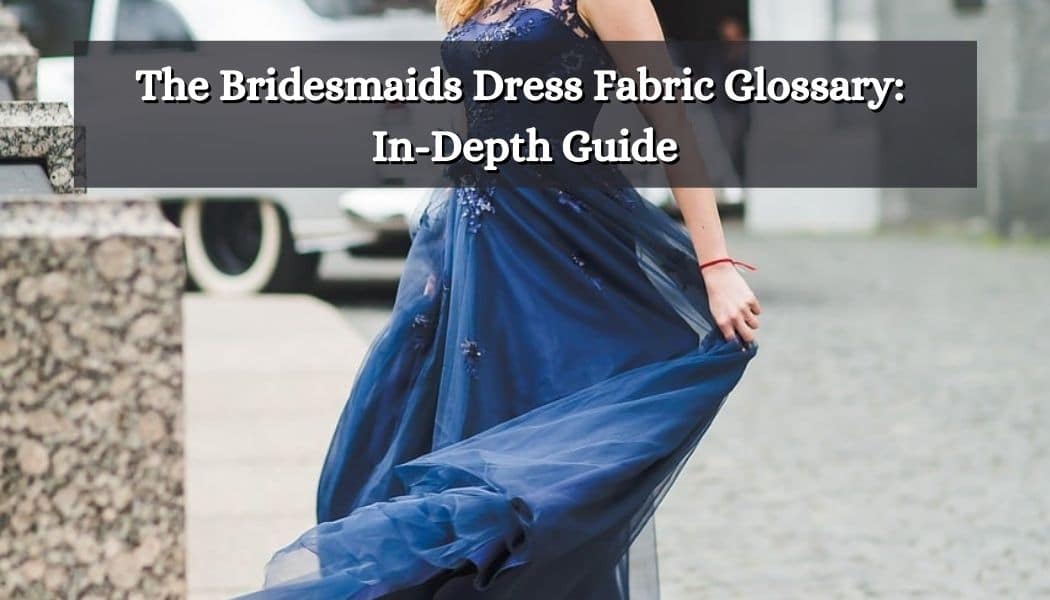
There is more to bridesmaids’ dresses than just colour and style. The fabric is an equally important factor. The material you choose has a significant impact on the overall effect of how your bridesmaids will look on your wedding day. For example, the same colour can be entirely different when done in two other fabrics. Similarly, the same dress pattern will drape differently depending on how structured or soft the fabric is.
Just like wedding gowns, bridesmaids’ dresses are available in different fabrics. When you know your options, you can find a dress that is better suited for the formality of your wedding. It is equally helpful to know what you will be getting if you are ordering your dresses online or aren’t attending the shopping session.
This primer on bridesmaids’ dress fabrics will provide you with the information you need to make your decision.
Table of Contents
Know the technical terms
You must have heard of terms like fabric, finish, fibres and blends, a lot. Unless you are a seasoned expert in textiles, all these terms may mean the same to you. However, each of these refers to different things. To understand what your options are, you should first understand what each of these terms means. Let us look at them now.
Fibres: Fibers refer to the strands used to make the yarn. They are the smallest or most basic unit of any piece of clothing. For example, a cotton dress is made from fibres of cotton, which comes from the cotton plant. Other fibres are wool, silk, and hemp.
Fabric: Fibers are woven or knitted together to create material. So, we can say that fibres are ingredients that join together to make fabrics. Yarn can be incorporated together in different ways, with variations in the number of horizontal threads and vertical threads used or in the way they are interlocked. So, depending on the pattern, the thickness and structure of the fabric will vary.
Blends: Blend refers to the different combinations of fibres in a fabric. It isn’t always necessary to use duplicate threads to make fabric. It is also possible to mix other fibres, so we get a better result. For example, cotton fibres may be combined with synthetic polyester to create durable and wrinkle-free fabric.
Finish: We spoke about how fibres from fabric go through the process of weaving or knitting. Finish refers to the final look and feel of the material after the processes that render it ready for use in a garment. For example, satin is a finish that can be achieved by combining different types of fibres. So, when a dress is said to be satin, it will have the silky sheen that is characteristic of silk. Nevertheless, it doesn’t need to be made out of silk fibres. The same finish can be achieved by suitable combinations of other yarns too.
Where bridesmaid’s dresses are concerned, we are more interested in finishes than the fabric, blend or fibres. So, let us start with the most common finishes seen in our collections at Best for Bride and learn about each of them in greater detail.
Chiffon
Chiffon is a lightweight, sheer fabric that is slightly see-through. It is light, slippery and softer than georgette, which it is often confused with. The main difference between the two is that chiffon is more lustrous and smoother. Chiffon doesn’t cling, and so it is a good choice for dresses with layers. It is commonly used in a layered style to cover up the light effect characteristic of the material. In addition, this light fabric feels cool on the skin. Hence, we think this material is ideal for outdoor weddings in the warmer months.
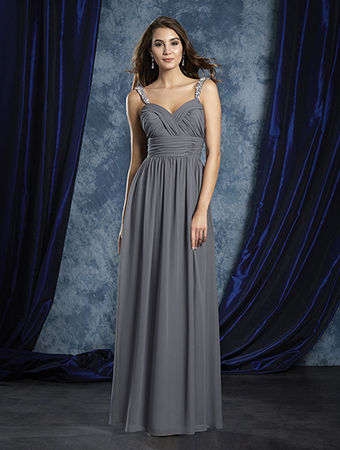
Satin
Satin refers to weaves with smooth and shiny surfaces and dull backs. Although satin was initially made from silk, nowadays, it is also made with synthetic varieties. Satin has a luxurious look and is what typically fits the description of the word “silky.” It is soft and lustrous and drapes snugly. Hence, it is a good choice for form-fitting dresses. The light glossy surface has a characteristic sheen. This makes the material great for nighttime events. However, it may not be the best choice for outdoor events in the warmer months, as it quickly shows sweat. The actual thickness and weight of the garment will depend on materials that have been used to craft the satin finish. So, you can expect a silk satin to feel different from satin made from rayon or polyester.
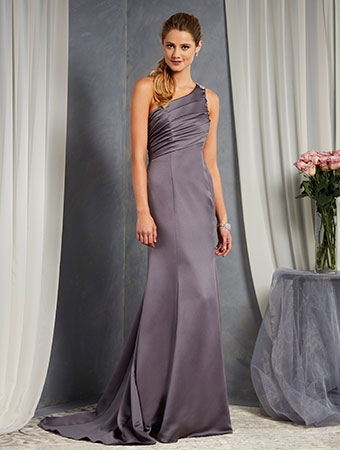
Georgette
Often confused with chiffon, georgette is also a thin, sheer fabric. However, the difference is that it is less lustrous but springier. In addition, it isn’t exciting in comparison to chiffon. Originally, georgette was fashioned out of silk. However, this finish is achieved using synthetic fibres like polyester these days. The characteristic feature of georgette is its crispy crepe-like structure, which is also the factor that distinguishes it from chiffon. It is also slightly heavier, but the drape is similar.
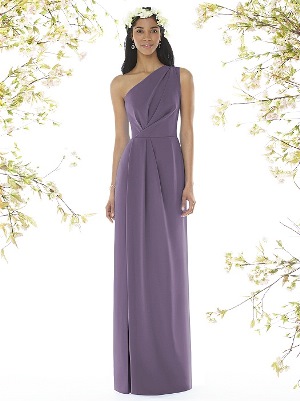
You can see how the fabric is more solid than the chiffon dress we saw earlier, while both fall similarly. This dress has one shoulder draped bodice detail and gathers at the skirt.
Mousseline
This is a lightweight sheer fabric with a silky finish and lustrous texture. Originally derived from silk, mousseline is now also available in synthetic fibre blends. Although it resembles chiffon in look, it is more structured and heavier. Therefore, it is sometimes also known as mousseline de soi. In addition, mousseline is often paired with a soft overlay for a more dramatic effect.
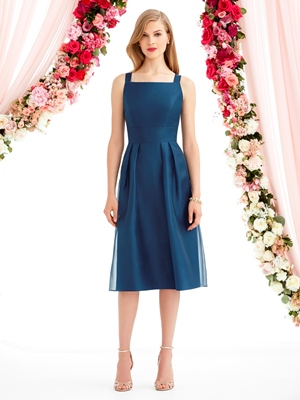
The bridesmaid dress shown here is a sleeveless dress that features a square neckline and an A-line skirt with peaceful gatherings. The back of the dress has criss-cross straps.
Tulle
The first thing that comes to mind when we hear the term tulle is tutus. This is similar to excellent netting. This finish is very lightweight and can be made from fibres, including cotton, silk, and nylon. It can add a defining layer to a dress and is used as the uppermost layer in skirts. The sheer nature of this fabric makes it necessary to use it in several layers or as an overlay. It is a material that is commonly used in wedding gowns. However, we can also find many bridesmaids’ collections featuring this material.
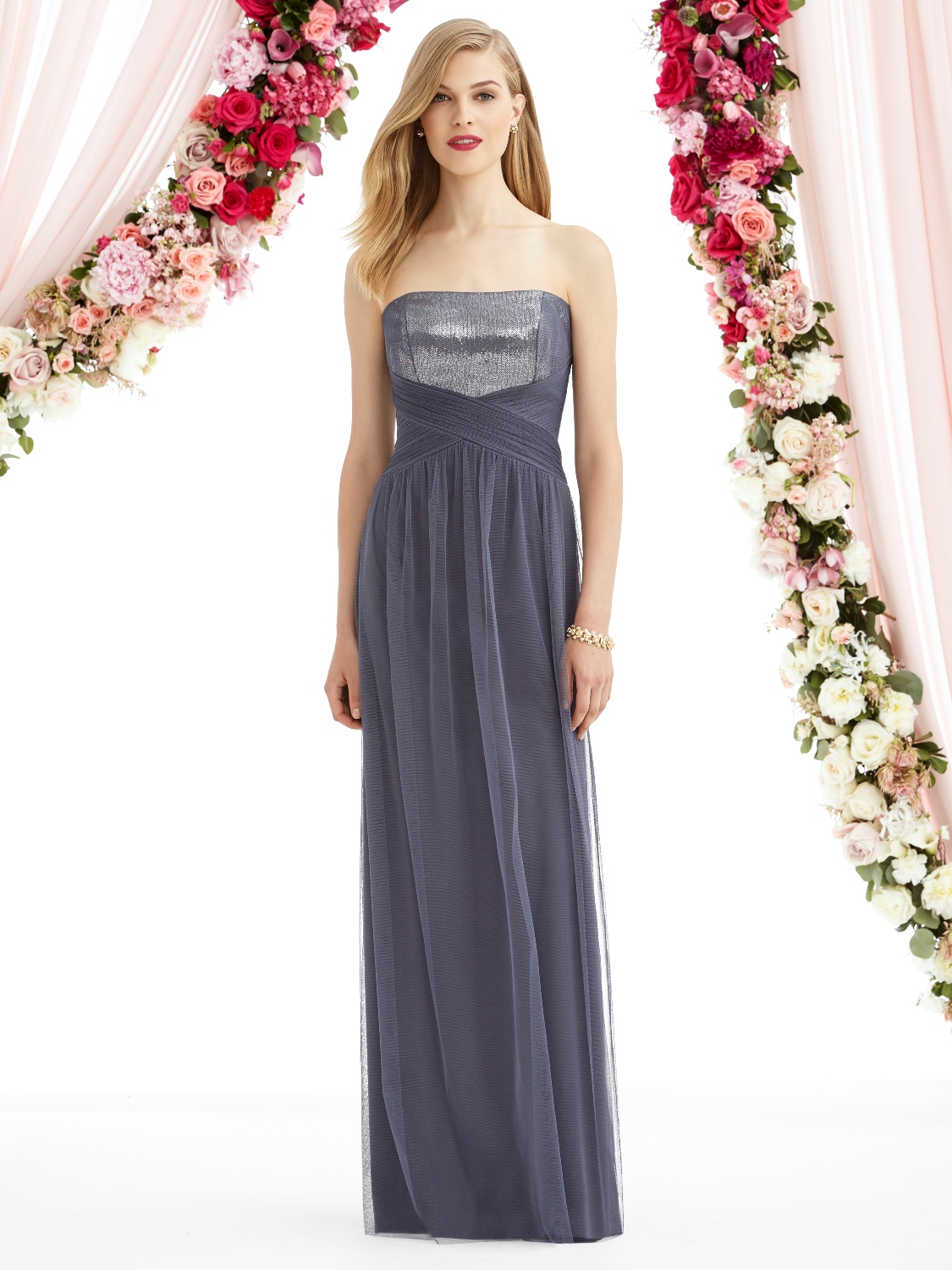
Here, soft tulle is used throughout, and there is a defining criss-cross detail at the waist. In addition, sequined embellishments are present on the bodice with a defined waistline, and the full-length skirt has a pleated detail.
Lace
The eternal vintage favourite lace possesses a web-like structure of intricate details, done by hand or machine. Lace can be made from cotton, silk or even synthetic yarns. Depending on the design and motifs used, lace takes different forms and different names. It is sheer and so has to have a thicker fabric layer beneath it. Lace can create beautiful illusion styles on the neckline, sleeves, and back when used without a lining. Ordinary laces include Florentine lace, Alencon lace, Chantilly lace and the more recent laser-cut 3-D lace.
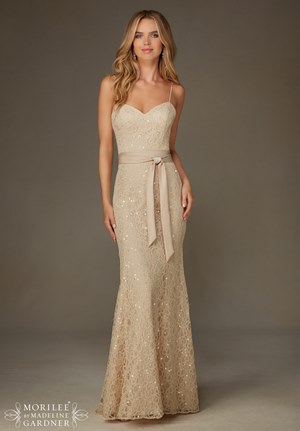
This Mori Lee gown is a beaded lace gown with a sweetheart neckline, spaghetti straps, and a modified A-line skirt. The beads encrusted on the lace used in this dress add a sparkling finish to the gown.
Dupioni
Dupioni is a crisp form of silk with an almost iridescent effect. This unique feature is achieved by the mixing of different colours of thread in the weaving. The fabric’s surface is lustrous, and the tight weave doesn’t allow light to pass through. The material is quite heavy, making it suitable for more relaxed evening receptions and weddings in winter or autumn. The uneven texture of the surface makes colours pop, making it an excellent choice for bright colours. It is also stiff and holds its shape.
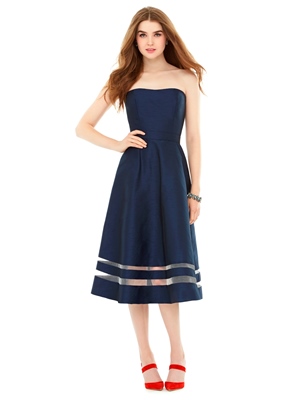
The gown from the Alfred Sung Spring collection is a splendid dress with a soft sweetheart neckline and an A-line skirt. The defined waistline and the illusion detail at the hem make it a brilliant and unique piece that every bridesmaid would love to be seen in.
Jersey
Jersey is a stretchy fabric because of its close-knit structure. It is lightweight, and the characteristic feature is that it has one flat side, with the wrong side showing fibre piling. When more than two single jersey layers are knit together, the finish is heavier, and the stretch is relatively reduced. Jersey has a beautiful drape, making it a fantastic choice for bridesmaids’ dresses. The interlocking knits make it very comfortable, and it may be the ideal choice if you are looking for a snug-fitting garment that feels comfortable too.
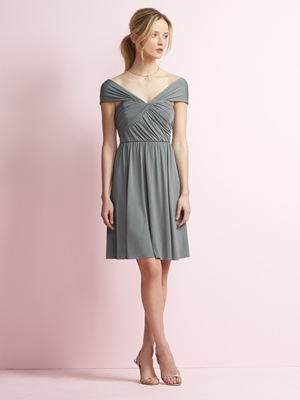
This dress has a V-neckline fashioned out of ruched cap sleeves that criss-cross across the bust. The ruched bodice ends at the natural waistline, from where the shirred skirt is easily distinguished.
Crepe
Crepe is a fabric with a crispy appearance, and it usually looks like it is crinkled. It can be made using different fibres, including silk and wool. Since the fabric is quite structured and rigid, it has a definite drape and doesn’t fall softly. However, it is lightweight and stretchy. The fibres that make up the crepe determine how heavy it is, and one form can be very distinct from the other in overall appearance and lustre.
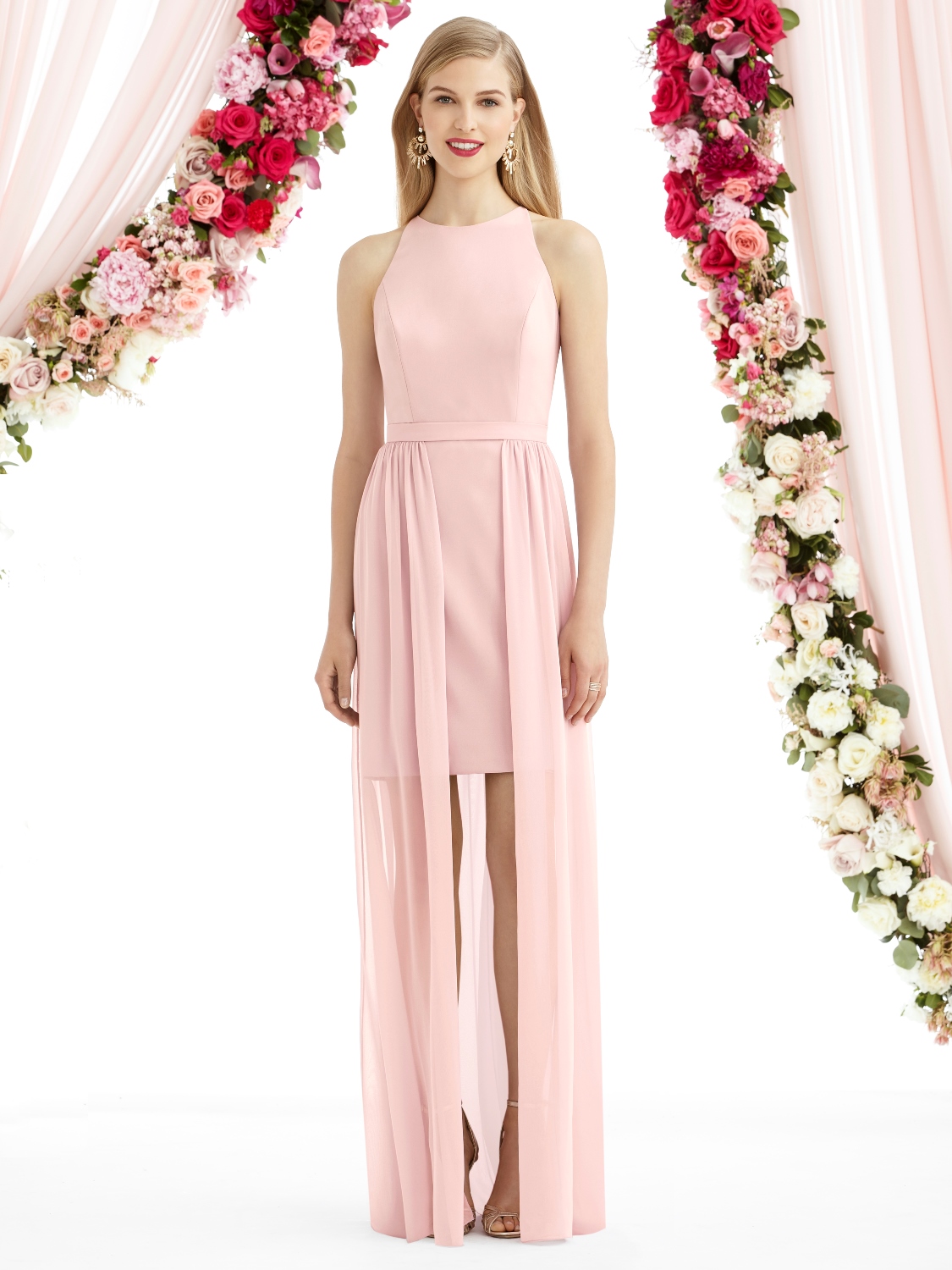
This dress belongs to the After Six bridesmaids collection. Crepe is the fabric that is used in this sheath cocktail-length dress. It also has a removable shirred skirt fashioned out of lux chiffon. The dress features a high scoop neckline, and the waistline is defined when the overlay skirt is chosen.
The two main factors to be remembered when choosing the finish for your bridesmaid’s dress are
- how suitable the material will be for the weather, and
- how it drapes on your bridesmaids.
Depending on the body structure of the different girls in your bridal party, you may like to play around with fabrics to find the best choice for each of them. For example, while slim and well-toned figures can carry off figure-clinging fabric finishes, it is better to go with more structured drapes when your girls don’t want to highlight certain parts of their bodies. A structured fabric will camouflage the less desirable aspects while drawing attention to their best features.
To explore more options in bridesmaids’ dresses or take a closer look at any of the dresses we have featured here, visit our online bridesmaid gallery at Best for Bride or walk into one of our stores. With leading designer collections that feature every fabric, finish, and design, you will have no trouble finding every dress you need to complete your vision of the perfect bridal party to compliment you on your special day.
Summary: The Bridesmaids Dress Fabric Glossary
- Understanding different fabrics is essential when choosing bridesmaids’ dresses to ensure the desired look and comfort.
- Chiffon is a lightweight, sheer fabric that drapes beautifully and is commonly used for flowing and romantic dresses.
- Satin is a glossy and smooth fabric with a lustrous finish, often used for formal and elegant bridesmaids’ dresses.
- Lace is a delicate and intricate fabric made of yarn or thread, adding a romantic and feminine touch to dresses.
- Tulle is a fine netting fabric that creates volume and adds a whimsical and ethereal look to bridesmaids’ dresses.
- Organza is a sheer and lightweight fabric with a crisp texture, perfect for creating structured and voluminous styles.
- Georgette is a slightly textured fabric that is lightweight and flowy, commonly used for draping and ruffled details.
- Crepe is a versatile fabric with a slight texture and a matte finish, suitable for both structured and flowy bridesmaids’ dresses.
- Jersey is a stretchy and comfortable fabric that hugs the body, ideal for creating sleek and form-fitting bridesmaids’ dresses.
- Silk is a luxurious and smooth fabric that exudes elegance and is often used for high-end bridesmaids’ dresses.
- Sequin fabric features small, shimmering discs that add sparkle and glamour to bridesmaids’ dresses, perfect for evening or festive weddings.
FAQ – Bridesmaids Gowns
Is it OK for bridesmaids to dress in black?
The major advantage of black is that it is universally the same shade, so if you want to let your bridesmaids choose their own gowns, you won’t have to worry about mismatched tones—your bridesmaids will appear put-together right away. Even better, picking a black bridesmaid’s gown ensures that your girls will be able to reuse their gown.
What do you put on top of a bridesmaid gown?
Jackets, along with a lovely cardigan, and some warm wraps or blankets, may be the greatest answer to the problem. Take a look at our photographs below to see all of the wonderful methods to keep your bridesmaids warm, and consider utilizing them if your wedding is in the winter.
Is it necessary for bridesmaids to match?
Modern brides are abandoning the traditional convention of having bridesmaids wear the same dress in favour of outfits that are mismatched in colour, design, and pattern. The result is a one-of-a-kind collection of stunning gowns that accentuate each woman’s distinctive form, style, and personality.
What is the best way for bridesmaids to pose?
The most important aspect of this posture is that everyone has a hand on the bride. Your bridesmaids should be at your sides. To ensure that everyone is in the picture, some of them may stand by your shoulders while others crouch at your legs. Encourage everyone to help you with your gown, veil, haircut, or shoes.
What is the proper way for bridesmaids to go down the aisle?
One by one or two by two, they make their way down the aisle. They line up in front of the bride, on the right side of the chuppah, with the first bridesmaid at the farthest position from the bride. The bridesmaids might create a diagonal line to ensure that everyone can see the pair.














Wow, that is a lot of terms that I never really knew about. I guess you are not just going to get a cotton dress 🙂 Thanks for the tips on these types of fabrics for wedding dresses.
I would totally leave this decision up to someone else 🙂
I think this is too involved. I just want to do something more simple. Its really just a a few hours on one day.
I LOVE that blue dress that has the red stripes on it! WOW. That is an amazing look!
Totally the same dress that caught my eye almost immediately!
Lace is elegant and other than satin or silk, I cannot think of another fabric that would be used for a wedding day!
Great post. This will be helpful to brides to be!
Look, there is a lot of fabric out there and you have narrowed the search for me very well. But there are so many factors that go into which to choose. The problem that I have is I am not sure what order to choose things. The destination first, then the dress, or the other way around?
Here is the thing. I really want to have a classy wedding dress. One that I can keep and possibly hand down. what is a good material for that?
Good question. I do not think you can go wrong with any material in this case. Good luck!
The Chiffon dress look outstanding!! classy collection.
Thanks for sharing
It’s good to know that chiffon is a lightweight fabric that can be used for dresses. My daughter is planning her wedding, and she wants to make sure that her bridesmaids have the right kind of dresses. I’ll pass this information along to her for her consideration.